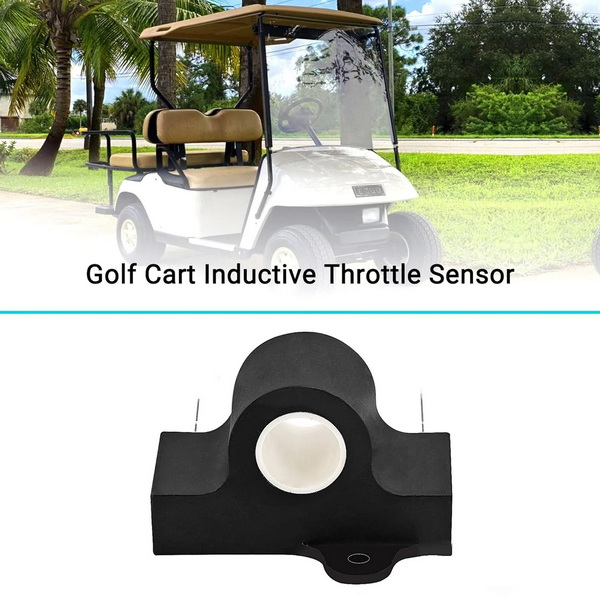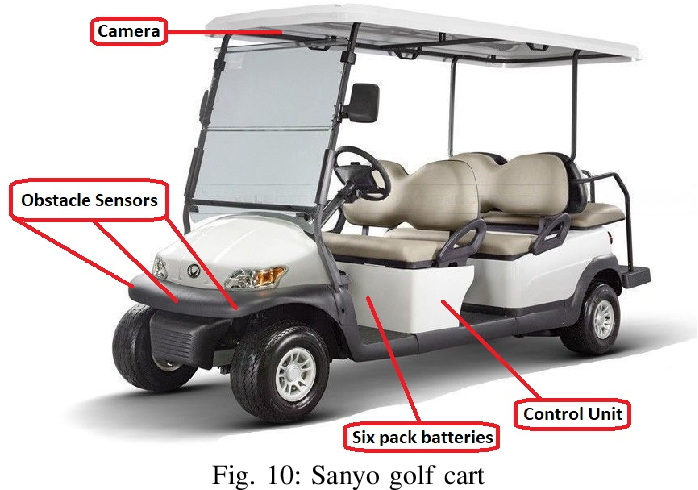Content Menu
● Introduction to Electric Golf Cart Sensors
● Types of Sensors Used in Electric Golf Carts
>> Speed Sensors
>>> Magnetic Speed Sensors
>>> Hall Effect Speed Sensors
>>> Optical Speed Sensors
>>> Pulsed Output Speed Sensors
>>> Variable Reluctance Speed Sensors
>> Navigation and Obstacle Detection Sensors
>>> Cameras
>>> LiDAR Sensors
>>> RADAR Sensors
>>> GPS Sensors
● Applications of Sensors in Electric Golf Carts
>> Safety Features
>> Autonomous Operation
>> Enhanced User Experience
● Maintenance and Troubleshooting of Sensors
● Advanced Sensor Technologies in Future Golf Carts
● Integration with Other Technologies
● Environmental Impact
● Conclusion
● FAQs
>> 1. What Types of Speed Sensors Are Commonly Used in Electric Golf Carts?
>> 2. How Do Autonomous Golf Carts Use Sensors for Navigation?
>> 3. What Is the Role of GPS Sensors in Electric Golf Carts?
>> 4. How Do Sensors Contribute to Safety in Electric Golf Carts?
>> 5. How Often Should Sensors in Electric Golf Carts Be Maintained?
Electric golf carts have evolved significantly over the years, incorporating advanced sensor technologies to enhance their performance, safety, and user experience. These sensors play a crucial role in monitoring and controlling various aspects of the golf cart, from speed and acceleration to navigation and obstacle detection. In this article, we will delve into the types of sensors commonly used in electric golf carts and explore their functions and applications.

Introduction to Electric Golf Cart Sensors
Electric golf carts rely on a variety of sensors to ensure smooth operation and safety. These sensors convert physical parameters into electrical signals, which are then processed by the cart's onboard computer to control different functions such as speed, direction, and braking. The most common types of sensors include:
- Speed Sensors: These are essential for monitoring the cart's speed and providing real-time feedback to the controller. Common types include magnetic, Hall effect, optical, pulsed output, and variable reluctance speed sensors.
- Navigation and Obstacle Detection Sensors: These include cameras, LiDAR (Light Detection and Ranging), RADAR (Radio Detection and Ranging), and GPS (Global Positioning System) sensors. They are used in autonomous golf carts to detect obstacles and navigate through paths.
Types of Sensors Used in Electric Golf Carts
Speed Sensors
Speed sensors are critical components in electric golf carts, as they monitor the rotation of the motor and provide feedback to the controller. This ensures precise control over the cart's speed, contributing to a smooth and responsive driving experience.
Magnetic Speed Sensors
Magnetic speed sensors detect the rotation of a magnet attached to the drive shaft or wheel hub. As the magnet passes by the sensor, it generates a signal that corresponds to the cart's speed. These sensors are widely used due to their simplicity and reliability.
Hall Effect Speed Sensors
Hall effect sensors use a semiconductor chip to measure the magnetic field produced by a moving magnet. They are known for their accuracy and reliability in speed measurement. These sensors are popular in both electric and traditional golf carts.
Optical Speed Sensors
Optical speed sensors use light to measure speed. They emit a beam of light towards a reflective target on the drive shaft or wheel hub and detect the change in the reflected light signal to calculate speed. While precise, they require reflective targets on moving parts.
Pulsed Output Speed Sensors
These sensors generate pulses corresponding to the cart's speed. The pulse frequency increases with speed, providing real-time speed information to the cart's controller or onboard computer.
Variable Reluctance Speed Sensors
Variable reluctance sensors measure changes in inductance between the sensor coil and a magnetic target. Although less common, they can be used in specific applications requiring speed measurement.
Navigation and Obstacle Detection Sensors
For autonomous operation, electric golf carts employ advanced sensors like cameras, LiDAR, RADAR, and GPS. These sensors enable the cart to detect obstacles, navigate through paths, and maintain safety.
Cameras
Cameras are used for visual detection of obstacles and pedestrians. They provide a wide field of view and are essential for autonomous navigation systems.
LiDAR Sensors
LiDAR sensors use laser light to create high-resolution maps of the environment. They are crucial for detecting obstacles and planning safe trajectories.
RADAR Sensors
RADAR sensors use radio waves to detect obstacles and measure distances. They are often used in conjunction with other sensors for enhanced safety.
GPS Sensors
GPS sensors provide location data, helping the cart navigate through predefined paths and ensuring it stays on course.

Applications of Sensors in Electric Golf Carts
Sensors in electric golf carts have various applications, from enhancing safety to improving user experience.
Safety Features
- Collision Avoidance: Advanced sensors like LiDAR and RADAR enable the cart to detect obstacles and avoid collisions, ensuring a safe ride.
- Speed Control: Speed sensors help maintain a consistent speed, preventing sudden acceleration or deceleration, which can be hazardous.
Autonomous Operation
Autonomous golf carts use a combination of sensors to navigate through paths without human intervention. This technology is particularly useful in golf courses and resorts, where carts can transport passengers or goods autonomously.
Enhanced User Experience
- Smooth Performance: Sensors ensure that the cart operates smoothly, providing a comfortable ride by maintaining consistent speed and acceleration.
- Real-time Feedback: Sensors provide real-time feedback to the controller, allowing for precise adjustments to speed and direction, enhancing the overall driving experience.
Maintenance and Troubleshooting of Sensors
Maintaining sensors is crucial for optimal performance. Here are some tips:
- Compatibility: Ensure that any new sensor is compatible with the cart's make and model.
- Regular Checks: Regularly inspect sensors for damage or malfunction. Clean or replace them as needed.
- Troubleshooting: Use diagnostic tools to identify issues. For example, if a speed sensor fails, the cart may default to a lower speed.
Advanced Sensor Technologies in Future Golf Carts
As technology continues to evolve, we can expect even more sophisticated sensor systems to be integrated into electric golf carts. For instance, advanced AI algorithms can be used to analyze data from multiple sensors, enhancing navigation and obstacle detection capabilities. Additionally, the integration of IoT (Internet of Things) technology could enable real-time monitoring and remote control of golf carts, further enhancing user experience and safety.
Integration with Other Technologies
The integration of sensors with other technologies like GPS and mapping software can provide additional features such as route optimization and traffic avoidance. This not only improves efficiency but also reduces the risk of accidents by avoiding congested areas.
Environmental Impact
Electric golf carts, equipped with advanced sensors, contribute to a more environmentally friendly transportation solution compared to traditional gas-powered carts. By reducing emissions and noise pollution, they offer a sustainable option for golf courses and resorts.
Conclusion
Electric golf carts rely heavily on advanced sensor technologies to enhance their performance, safety, and user experience. From speed sensors to navigation and obstacle detection sensors, these components play a vital role in ensuring smooth operation and autonomous functionality. As technology continues to evolve, we can expect even more sophisticated sensor systems to be integrated into electric golf carts.

FAQs
1. What Types of Speed Sensors Are Commonly Used in Electric Golf Carts?
Common types include magnetic, Hall effect, optical, pulsed output, and variable reluctance speed sensors. Each type has its advantages and is chosen based on the specific requirements of the golf cart.
2. How Do Autonomous Golf Carts Use Sensors for Navigation?
Autonomous golf carts use a combination of sensors like cameras, LiDAR, RADAR, and GPS to detect obstacles, navigate through paths, and maintain safety. These sensors provide real-time data that helps the cart adjust its trajectory.
3. What Is the Role of GPS Sensors in Electric Golf Carts?
GPS sensors provide location data, helping the cart navigate through predefined paths and ensuring it stays on course. This is particularly useful in autonomous golf carts.
4. How Do Sensors Contribute to Safety in Electric Golf Carts?
Sensors contribute to safety by enabling features like collision avoidance and speed control. They help prevent accidents by detecting obstacles and maintaining a consistent speed.
5. How Often Should Sensors in Electric Golf Carts Be Maintained?
Sensors should be regularly inspected for damage or malfunction. Cleaning or replacing them as needed ensures optimal performance and extends their lifespan.










































